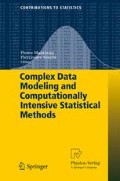Abstract
This paper proposes a supervised classification approach for the differential diagnosis of Raynaud’s Phenomenon on the basis of functional infrared imaging (IR) data. The segmentation and registration of IR images are briefly discussed and two texture analysis techniques are introduced in a spatio-temporal framework to deal with the feature extraction problem. The classification of data from healthy subjects and from patients suffering from primary and secondary Raynaud’s Phenomenon is performed by using Stepwise Linear Discriminant Analysis (LDA) on a large number of features extracted from the images. The results of the proposed methodology are shown and discussed for a temporal sequence of images related to 44 subjects.
Access this chapter
Tax calculation will be finalised at checkout
Purchases are for personal use only
Preview
Unable to display preview. Download preview PDF.
References
Barker, M., Rayens, W.: Partial Least Squares for Discrimination. Journal of Chemometrics 17, 166–173 (2003)
Belch, J.: Raynaud’s phenomenon. Its relevance to scleroderma. Ann. Rheum. Dis. 50, 839–845 (2005)
Besag, J.E., Moran, A.P.: On the estimation and testing of spatial interaction in Gaussian lattice processes. Biometrika 62, 555–562 (1975)
Block, J.A., Sequeira, W.: Raynaud’s phenomenon. Lancet 357, 2042–2048 (2001)
Chang, J.S., Liao, H.Y.M., Hor, M.K., Hsieh, J.W., Cgern, M.Y.: New automatic multilevel thresholding technique for segmentation of thermal images. Images and vision computing 15, 23–34 (1997)
Cressie, N.A.: Statistics for spatial data. second edn., Wiley and Sons, New York, (1993)
Cocquerez, J.P., Philipp, S.: Analyse d’images: filtrage et segmentation. Masson, Paris (1995)
Dryden, I.L., Ippoliti, L., Romagnoli, L.: Adjusted maximum likelihood and pseudo-likelihood estimation for noisy Gaussian Markov randomfields. Journal of Computational and Graphical Statistics 11, 370–388 (2002)
Fontanella, L., Ippoliti, L., Martin, R.J., Trivisonno, S.: Interpolation of Spatial and Spatio-Temporal Gaussian Fields using Gaussian Markov Random Fields. Advances in Data Analysis and Classification 2, 63–79 (2008)
Heriansyak, R., Abu-Bakar, S.A.R.: Defect detection in thermal image for nondestructive evaluation of petrochemical equipments. NDT&E International 42, 729–740 (2009)
Jarc, A., Pers, J., Rogelj, P., Perse, M., Kovacic, S.: Texture features for affine registration of thermal and visible images. Computer Vision Winter Workshop (2007)
Johnson, R.A., Wichern, D.W.: Applied Multivariate Statistical Analysis. sixth edn., Pearson education, Prentice Hall, London (2007)
Maldague, X.P.V.: Theory and practice of infrared technology for nondestructive Testing. Wiley Interscience, New York (2001)
Merla, A., Romani, G.L., Di Luzio, S., Di Donato, L., Farina, G., Proietti, M., Pisarri, S., Salsano, S.: Raynaud’s phenomenon: infrared functional imaging applied to diagnosis and drug effect. Int. J. Immunopathol. Pharmacol. 15(1), 41–52 (2002a)
Merla, A., Di Donato, L., Pisarri, S., Proietti, M., Salsano, F., Romani, G.L.: Infrared Functional Imaging Applied to Raynaud’s Phenomenon. IEEE Eng. Med. Biol. Mag. 6(73), 41–52 (2002b)
Rue, H., Held, L.: Gaussian Markov random Fields. Theory and Applications. Chapman and Hall/CRC, Boca Raton (2005)
Scribner, D.A., Schuller, J.M., Warren, P., Howard, J.G., Kruer, M.R.: Image preprocessing for the infrared. Proceedings of SPIE, the International Society for Optical Engineering 4028, 222–233 (2000)
Semmlow, J.L.: Biosignal and Biomedical Image Processing. CRC Press, Boca Raton (2004)
Tibshirani, B.: Regression shrinkage and selection via the Lasso. Journal of the Royal Statistical Society, Series B, 58, 267–288 (1996)
Zitova, B., Flusser, J.: Image registration methods: a survey. Image andVision Computing 21, 977–1000 (2003)
Author information
Authors and Affiliations
Editor information
Editors and Affiliations
Rights and permissions
Copyright information
© 2010 Springer-Verlag Italia
About this chapter
Cite this chapter
Aretusi, G., Fontanella, L., Ippoliti, L., Merla, A. (2010). Space-time texture analysis in thermal infrared imaging for classification of Raynaud’s Phenomenon. In: Mantovan, P., Secchi, P. (eds) Complex Data Modeling and Computationally Intensive Statistical Methods. Contributions to Statistics. Springer, Milano. https://doi.org/10.1007/978-88-470-1386-5_1
Download citation
DOI: https://doi.org/10.1007/978-88-470-1386-5_1
Publisher Name: Springer, Milano
Print ISBN: 978-88-470-1385-8
Online ISBN: 978-88-470-1386-5
eBook Packages: Mathematics and StatisticsMathematics and Statistics (R0)

